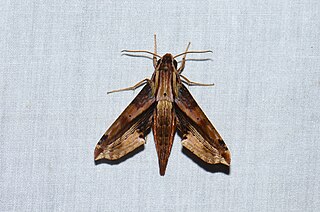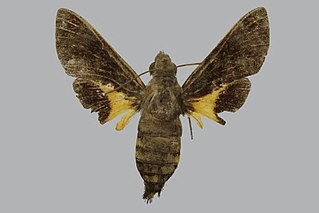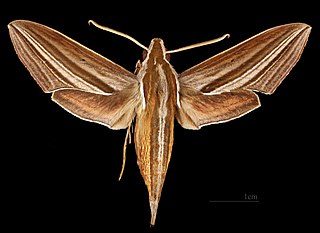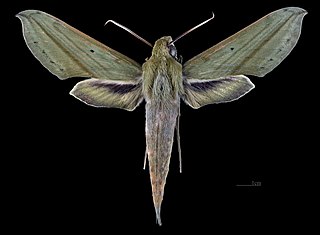
Cethosia cyane, the leopard lacewing, is a species of heliconiine butterfly found from India to southern China, and Indochina. Its range has expanded in the last few decades, and its arrival in the southern part of the Malay Peninsula, including Singapore, is relatively recent.

The Indian fritillary is a species of butterfly of the nymphalid or brush-footed family. It is usually found from south and southeast Asia to Australia.

Eumorpha phorbas is a moth of the family Sphingidae.

Eupanacra mydon, the common rippled hawkmoth, is a moth of the family Sphingidae.

Macroglossum aesalon is a moth of the family Sphingidae first described by Paul Mabille in 1879. It is known from Madagascar, Mauritius and the Comoro Islands.

Macroglossum affictitia, the dark-bordered hummingbird hawkmoth, is a moth of the family Sphingidae. It is known from Sri Lanka and southern India to Myanmar, Thailand and south-western Yunnan, China. It was described by Arthur Gardiner Butler in 1875.

Macroglossum castaneum is a moth of the family Sphingidae. It is known from the Solomon Islands.

Macroglossum eichhorni is a moth of the family Sphingidae. It is known from the Solomon Islands.

Macroglossum fritzei is a moth of the family Sphingidae. It is known from south-eastern China, central and southern Japan, Thailand and Borneo.

Macroglossum gyrans is a moth of the family Sphingidae. It was described by Francis Walker in 1856 and is known from South-east Asia and Madagascar.

Macroglossum milvus is a moth of the family Sphingidae. It is known from Réunion and Mauritius.

Erebia pandrose, the dewy ringlet, is a member of the subfamily Satyrinae of the family Nymphalidae. It is found from the Arctic areas of northern Europe, the Pyrenees, Alps, the Apennine Mountains, the Carpathian Mountains, Kola Peninsula and Kanin Peninsula, part of the Ural and the Altai and Sayan Mountains up to Mongolia.

Theretra lycetus, the white-edged hunter hawkmoth, is a moth of the family Sphingidae. It was described by Pieter Cramer in 1775.

Xylophanes elara is a moth of the family Sphingidae first described by Herbert Druce in 1878. It is known from Paraguay, Suriname, Venezuela, Bolivia and Brazil.

Xylophanes resta is a moth of the family Sphingidae.

Eurypteryx shelfordi is a moth of the family Sphingidae first described by Rothschild and Jordan in 1903. It is known from Borneo and Sumatra.

Eupanacra busiris, the green rippled hawkmoth, is a moth of the family Sphingidae.

Cechetra minor, the lesser green hawkmoth, is a moth of the family Sphingidae.

Oryba achemenides is a moth of the family Sphingidae.

Manduca trimacula is a moth of the family Sphingidae. It is found from Colombia to Ecuador, Venezuela and Bolivia.
























